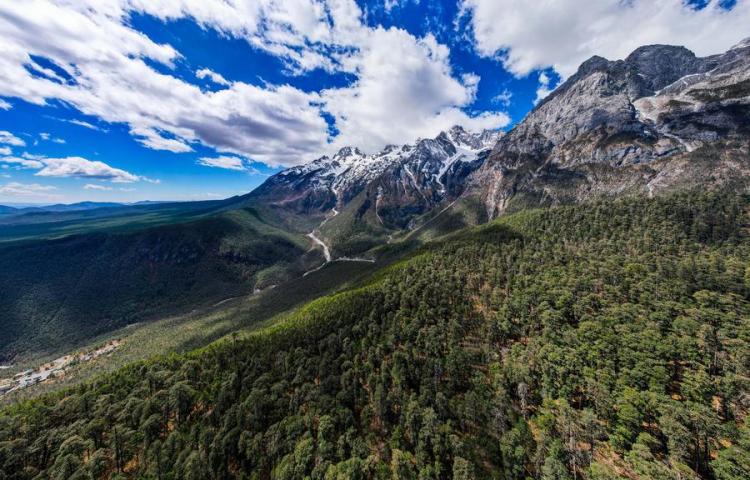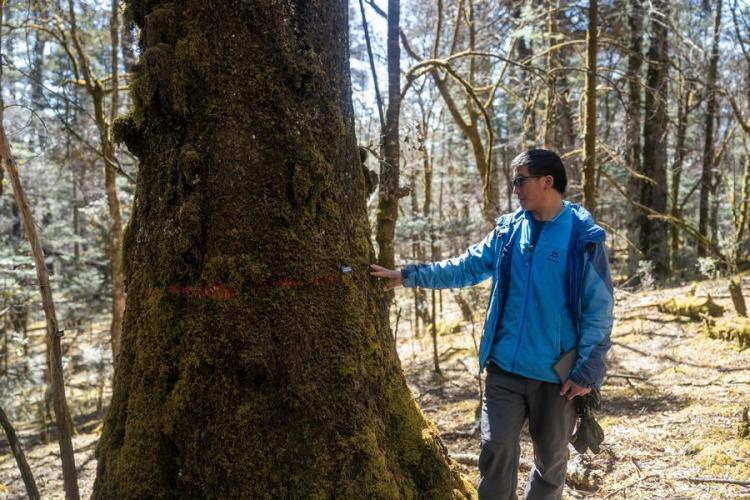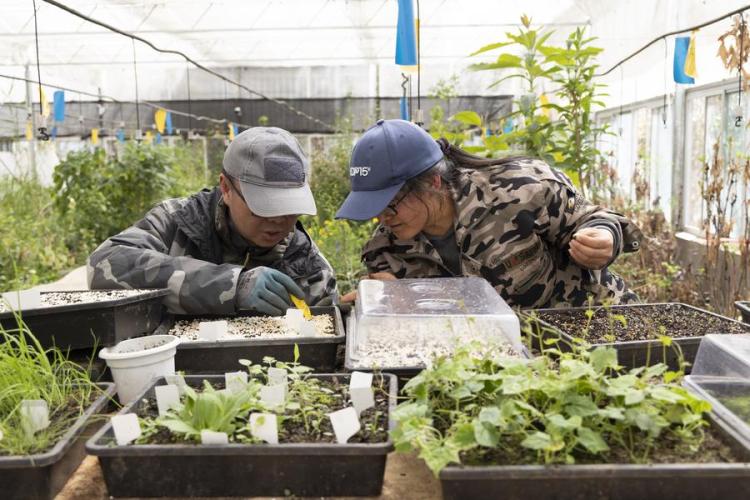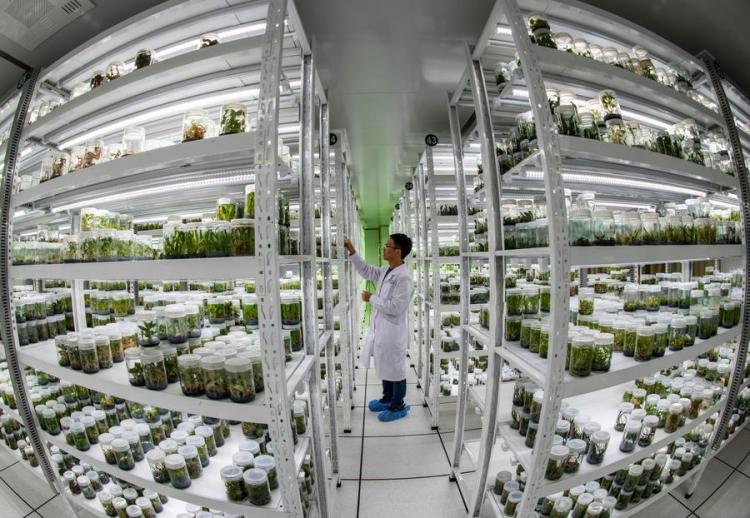
An aerial drone photo taken on March 28, 2024 shows the Lijiang Alpine Botanic Garden with the Yulong Snow Mountain, southwest China's Yunnan Province. (Xinhua/Chen Xinbo)
Engineer Fan Zhongyu is well acquainted with the status of over 47,000 trees in a primeval forest beneath the Jade Dragon Snow Mountain in southwest China's Yunnan Province, as if they were extensions of his own abode.
Fan, who works at Lijiang Forest Biodiversity National Observation and Research Station, Kunming Institute of Botany (KIB), Chinese Academy of Sciences, has dedicated over a decade to collecting leaves and seeds, observing seedlings, measuring and monitoring trees in a forest sample plot at an altitude of about 3,200 meters.
"We hope that through decades of long-term monitoring and observing the laws of forest and biodiversity development, we can accumulate observation data for future generations," Fan said.

Fan Zhongyu observes a fir at a sample area in Lijiang Alpine Botanic Garden in Lijiang, southwest China's Yunnan Province, March 28, 2024. (Xinhua/Chen Xinbo)
Lijiang station is situated in the transitional zone from the Qinghai-Xizang Plateau to the Yunnan-Guizhou Plateau in northwestern Yunnan, which stands as one of the global biodiversity hotspots, a paramount area for biodiversity conservation, and a repository of biological germplasm resources in China.
Scientists have been carrying out long-term observation of the forest biodiversity system of northwestern Yunnan, using technologies such as forest canopy tower crane and satellite remote sensing.
Similar to Fan, many of his colleagues consider the wilderness their home. Xu Kun, the deputy director of Lijiang station, and his team members spend nearly half a year in the field, conducting species surveys during the spring plant flowering season, gathering plant seeds in the fall, and organizing collected specimens and information in the winter.
"We have carried out observation surveys on species at an altitude of 2,000 to 4,500 meters in northwestern Yunnan to obtain first-hand data, and have now collected and preserved more than 2,600 important wild plant germplasm resources," Xu Kun said.
"We leverage bio-technology to address the reproductive challenges of endangered species, with the intent of reintroducing them into the wild for ecological reconstruction and restoration in the future," he added.

Xu Kun (L) and researcher Chen Xiaoling observe the germination of seeds at the Lijiang Alpine Botanic Garden in Lijiang, southwest China's Yunnan Province, March 27, 2024. (Xinhua/Jin Liwang)
At present, the Lijiang station has been equipped with facilities such as the seed bank of wild plants and greenhouses, forming a complete research system including investigation, collection, preservation, research and development, and production.
The researchers have carried out collaborative research with scientists from Britain, the United States, Canada, Germany, Japan and other countries in various fields such as biodiversity conservation, plant diversity formation and evolution, and forest ecosystem function.
Furthermore, Chinese scientists are elevating biodiversity monitoring and conservation to new heights. The Yunnan Alpine Subnival Ecosystem Observation and Research Station at Baima Snow Mountain in Diqing, the highest scientific research observatory in Yunnan, has been established.
The station features meteorological observation fields and sample plots at altitudes of nearly 5,000 and 4,300 meters, furnishing robust scientific backing for biodiversity research and conservation.
According to Yang Yang, deputy director of Baima station, who has dedicated over two decades of work at Baima Snow Mountain, the oxygen content of the alpine zone is only about 70 percent of that at lower altitudes, and the region remains cold throughout the year, compelling plants to exhaust all their resources in order to thrive in this stressful environment. "We hope to understand their survival mechanisms at high altitudes."
"Additionally, the alpine glacial margin stands as one of the most vulnerable regions to global climate change, and we are keen to discern how plants in alpine habitats are reacting to these changes," Yang added.
Scientists have established a greenhouse at the Baima station and are planning simulated warming experiments to investigate the responses of the subnival plants to global warming, aiming to offer theoretical support and scientific guidance for the protection of these plants.

Photo taken on Oct. 20, 2021 shows the vitro storage room at the Germplasm Bank of Wild Species in Kunming, southwest China's Yunnan Province. (Xinhua/Jiang Wenyao)
Moreover, scientists have established the Germplasms Bank of Wild Species at the KIB, the largest of its kind in Asia. Dubbed the "Noah's Ark" of plants in China, the seed bank preserved more than 94,000 plant seeds of over 11,000 species.
"Situated in the Himalaya-Hengduan Mountains region, we explore the phylogeny and evolutionary processes of plants, recognizing this region as one of the 36 most critical biodiversity areas globally," said Li Hongwei, deputy director of the KIB.
"The Earth's ecosystem shares a common destiny, and safeguarding natural biodiversity equates to securing the future of our species," Li added. (Xinhua)
(Editor:YANG Mei)




